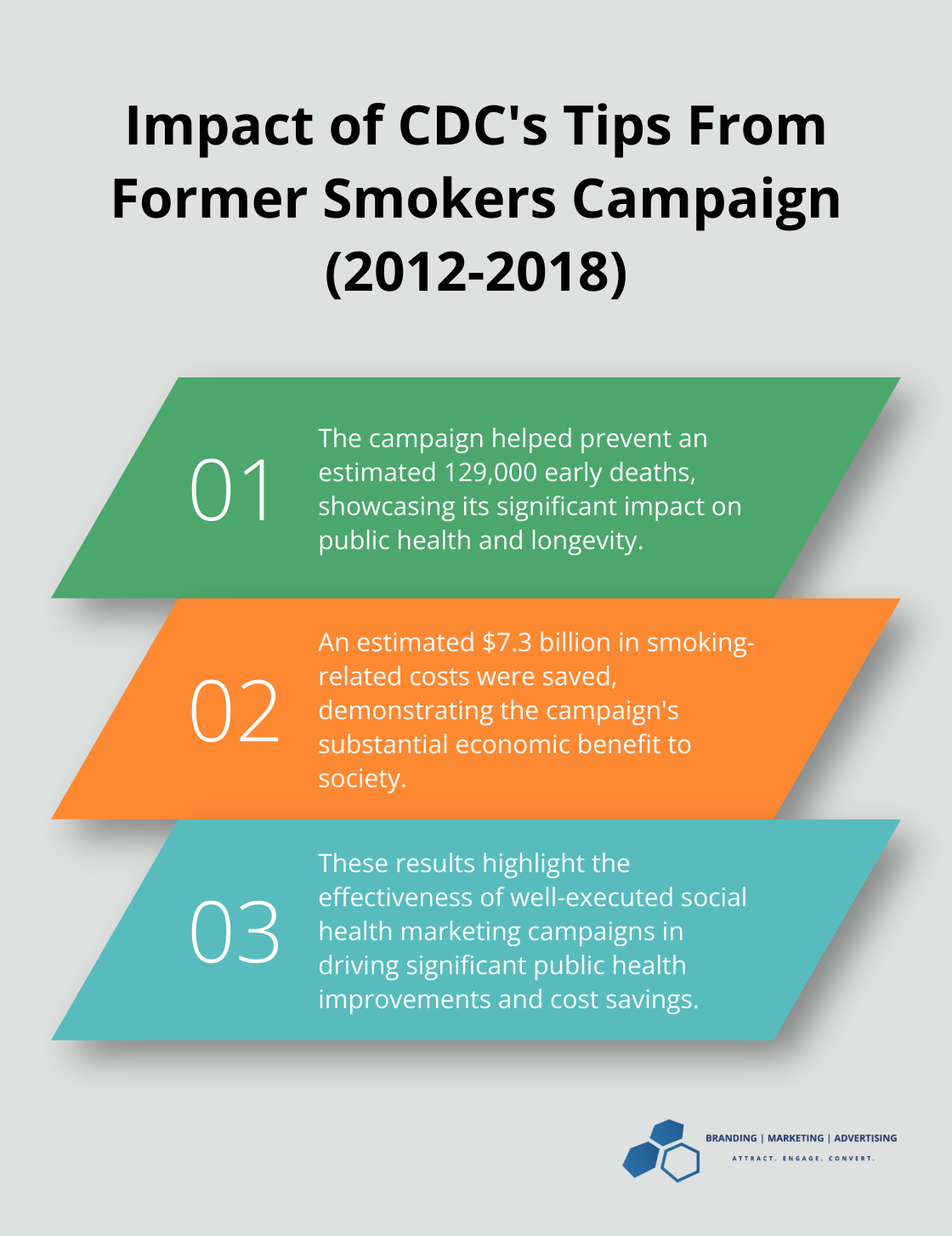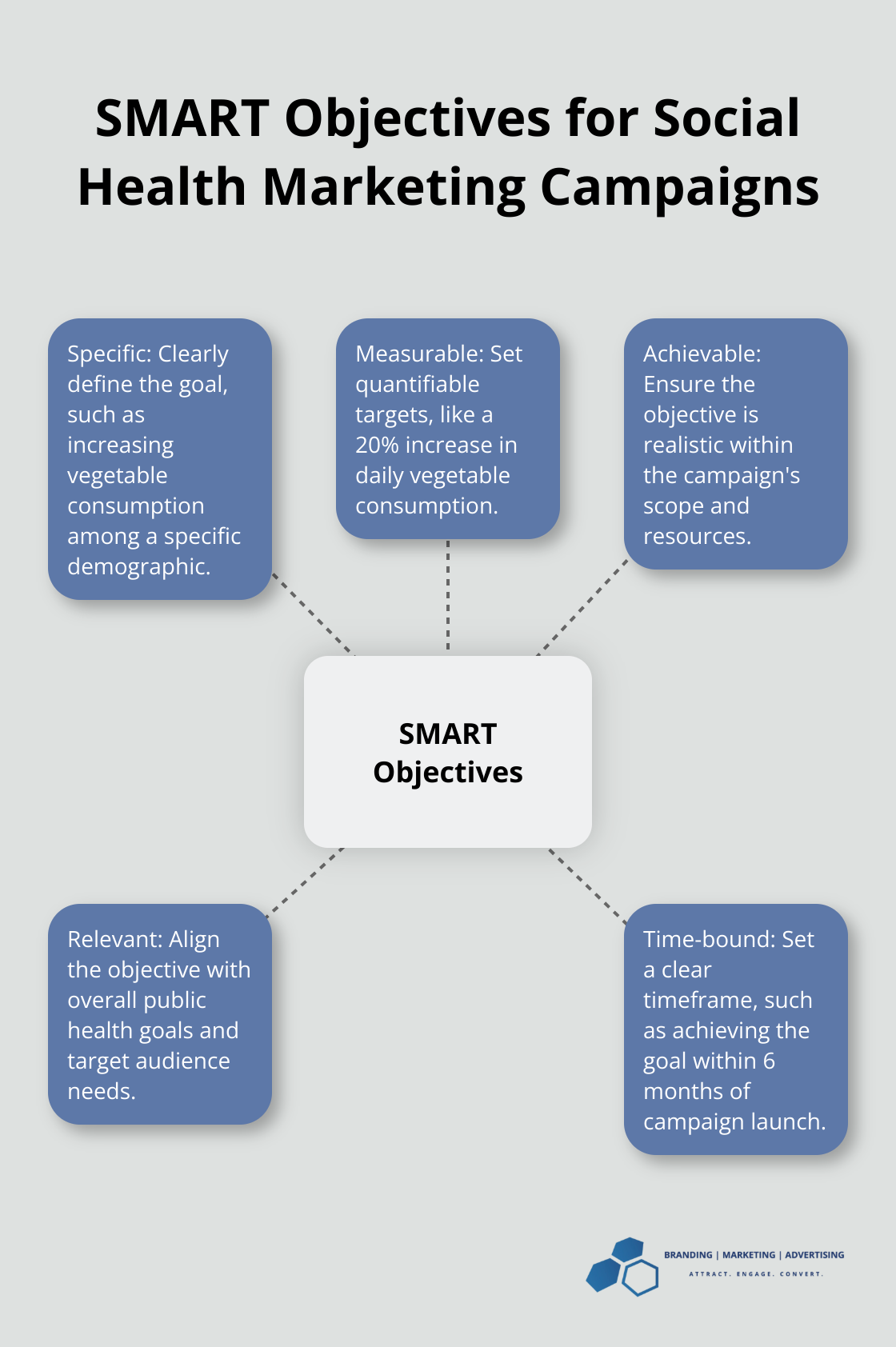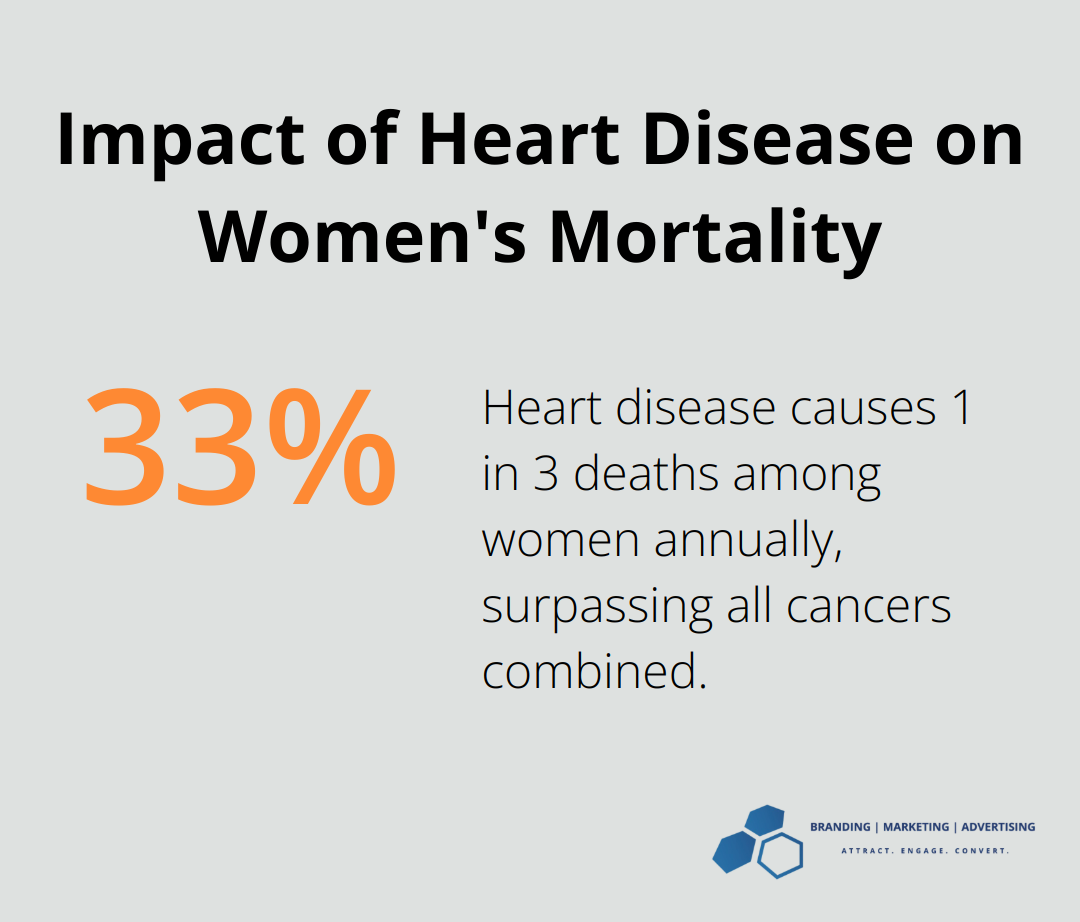How to Create Effective Social Health Marketing Campaigns
Social marketing health campaigns have become a powerful tool in promoting public well-being. At Branding | Marketing | Advertising, we’ve seen firsthand how these initiatives can drive positive behavioral change on a large scale.
This blog post will guide you through the essential elements of creating effective social health marketing campaigns. From developing a strategic framework to crafting compelling messages, we’ll share practical insights to help you make a real impact on public health.
What Is Social Health Marketing?
Social health marketing combines marketing principles with public health goals to promote positive behavioral changes. This powerful approach has significantly impacted community well-being.
Defining Social Health Marketing
Social health marketing uses commercial marketing techniques to influence voluntary behavior change for the benefit of individuals and society. Unlike traditional marketing that sells products or services, social health marketing promotes healthier lifestyles and behaviors.
A campaign to reduce smoking rates might use targeted messaging, emotional appeals, and strategic ad placement to encourage smokers to quit. This approach goes beyond providing information – it actively motivates and supports behavior change.
The Unique Aspects of Social Health Marketing
While traditional marketing and social health marketing share some techniques, key differences exist. Social health marketing often addresses sensitive topics, requires long-term behavior change, and faces more complex barriers to adoption.
A major challenge involves overcoming ingrained habits or societal norms. For instance, a campaign promoting safe sex practices must address individual behaviors and cultural attitudes surrounding sexual health.
Impact on Public Health Initiatives
Social health marketing has become an essential tool in public health. It allows health organizations to reach wider audiences, tailor messages to specific groups, and create more engaging and persuasive campaigns.
The Centers for Disease Control and Prevention (CDC) reported that their Tips From Former Smokers campaign helped prevent an estimated 129,000 early deaths and helped save an estimated $7.3 billion in smoking-related costs during 2012-2018. This demonstrates the potential of well-executed social health marketing campaigns to drive significant public health improvements.

Leveraging Digital Platforms
Digital platforms have revolutionized social health marketing. Social media, in particular, allows for highly targeted messaging and real-time engagement with audiences.
Measuring Success in Social Health Marketing
Unlike commercial marketing, where success often measures sales or profits, social health marketing requires different metrics. These might include changes in awareness levels, shifts in attitudes, or adoption of new behaviors.
For instance, a campaign aimed at increasing vaccination rates might track the number of people who get vaccinated, changes in attitudes towards vaccines, and the reach and engagement of campaign messages.
The Role of Partnerships in Social Health Marketing
Successful social health marketing often involves partnerships between health organizations, community groups, and marketing agencies. These collaborations bring together health expertise, community insights, and marketing skills to create more effective campaigns.
A campaign to promote healthy eating might partner with local farmers’ markets, nutritionists, and schools to create a comprehensive program that goes beyond advertising messages.
Ethical Considerations in Social Health Marketing
While social health marketing can be highly effective, it’s important to approach it ethically. Campaigns should base on accurate health information, respect individual autonomy, and avoid stigmatizing or marginalizing any groups.
The Future of Social Health Marketing
As technology evolves and our understanding of behavior change deepens, social health marketing will continue to innovate. We see trends towards more personalized health messaging, increased use of AI and data analytics, and greater integration of social health marketing with other public health strategies.
Understanding and leveraging the unique aspects of social health marketing allows organizations to create more impactful campaigns that truly make a difference in public health. Now, let’s explore how to develop a strategic framework for these campaigns, which forms the foundation of any successful social health marketing initiative.
How to Build a Strategic Framework for Social Health Marketing
At Branding | Marketing | Advertising, we know that a solid strategic framework forms the backbone of any successful social health marketing campaign. This chapter will guide you through the essential steps to create a framework that drives real results.
Pinpoint Your Audience and Health Behaviors
The first step in developing your strategy is to clearly define your target audience and the specific health behaviors you want to influence. This isn’t just about demographics – it’s about understanding the psychographics, motivations, and barriers of your audience.
For example, a campaign to increase HPV vaccination rates might target parents of pre-teens. Research shows that parents’ concerns about vaccine safety are a major barrier. Addressing these concerns directly in your messaging can significantly boost campaign effectiveness.
The CDC’s National Adult Tobacco Survey provides valuable insights into smoking behaviors across different demographics. Use similar data sources relevant to your health topic to inform your audience targeting.
Set SMART Objectives
Your objectives should be Specific, Measurable, Achievable, Relevant, and Time-bound (SMART). This approach ensures your goals are clear and you can track progress effectively.
For instance, instead of a vague goal like “increase vegetable consumption,” a SMART objective might be: “Increase daily vegetable consumption among adults aged 25-40 in [specific city] by 20% within 6 months of campaign launch.”

Select the Right Communication Channels
Choose channels that align with your audience’s media habits and preferences. A mix of traditional and digital channels often works best for broad reach and engagement.
Social media platforms (like Facebook and Instagram) are powerful tools for health campaigns. They allow for targeted messaging and real-time engagement. The American Heart Association’s #GoRedForWomen campaign on social media reached millions, driving awareness and action for heart health.
Don’t overlook offline channels. Community events, partnerships with local healthcare providers, and outdoor advertising can be highly effective, especially for reaching underserved populations.
Apply Behavioral Change Theories
Integrate proven behavioral change theories into your strategy. The Health Belief Model has been applied in diverse contexts, from chronic disease prevention to health education and promotion to evaluation of the effectiveness of interventions.
The Transtheoretical Model (Stages of Change) explains an individual’s readiness to change their behavior. It describes the process of behavior change as occurring in stages.
The most effective campaigns go beyond simply providing information. They address the emotional and practical barriers to behavior change. For instance, a campaign to promote regular cancer screenings might focus on overcoming fear and emphasizing the benefits of early detection.
A robust strategic framework will guide your creative decisions, resource allocation, and measurement efforts. In the next chapter, we’ll explore how to craft compelling messages and content that resonate with your audience and drive behavior change.
<a href=”https://bestbma.com/how-to-use-social-marketing-for-public-health-success/”>Learn more about social marketing for public health</a>
<a href=”https://bestbma.com/how-to-create-effective-health-advertising-campaigns/”>Discover effective health advertising campaigns</a>
<a href=”https://bestbma.com/how-to-create-a-successful-healthcare-marketing-plan/”>Create a successful healthcare marketing plan</a>
<a href=”https://bestbma.com/how-to-measure-roi-in-healthcare-marketing/”>Measure ROI in healthcare marketing</a>
How to Craft Compelling Health Messages
The Power of Storytelling in Health Campaigns
Stories connect with people on an emotional level. When you create your health messages, use real-life narratives that your audience can relate to. The CDC’s Tips From Former Smokers campaign featured personal stories from individuals affected by smoking-related illnesses. From 2012 to 2018, the campaign was found to help prevent 129,100 smoking-related deaths and reduce healthcare spending by $7.3 billion.
To create effective stories:
- Use authentic experiences and genuine emotions.
- Align the story with your target audience’s experiences.
- Show the struggle and the positive outcome of health behavior change.
Tapping into Emotions for Lasting Impact
Emotional appeals can be incredibly effective in health marketing. Fear, hope, empathy, and pride all motivate powerfully. However, you must strike the right balance. While fear grabs attention, pairing it with empowering messages often leads to better outcomes.
The Truth Initiative’s anti-smoking campaigns effectively use a mix of shocking statistics and empowering messages to motivate teens to avoid smoking.
Incorporating Credible Health Information
While emotional appeals matter, your campaign must also provide accurate, trustworthy health information. Partner with respected health organizations or cite reputable studies to boost your credibility.
The American Heart Association’s Go Red for Women campaign combines emotional storytelling with evidence-based heart health information. Heart disease causes 1 in 3 deaths among women each year – more than all cancers combined.

Visual Engagement: Beyond Pretty Pictures
In today’s digital age, visual content reigns supreme. Infographics, videos, and interactive content can break down complex health information into digestible, shareable formats.
The World Health Organization’s infographics on COVID-19 prevention measures were shared millions of times across social media platforms, helping to disseminate vital health information quickly and widely.
When you create visual content:
- Focus on one key message per visual.
- Choose colors that evoke the right emotions for your message.
- Make your visuals easy to understand for all audience segments.
Tailoring Messages for Different Platforms
Each communication channel has its own strengths and audience expectations. Tailor your content accordingly:
- Social media: Short, snappy messages with eye-catching visuals work best.
- Websites: Provide more in-depth information and resources.
- Email campaigns: Personalize content based on user preferences and behaviors.
The National Institutes of Health’s social marketing strategy exemplifies this approach, using platform-specific content to engage different audience segments effectively.
By crafting compelling health messages using these strategies, you can create effective health advertising campaigns that resonate with your audience and drive positive health outcomes.
Final Thoughts
Social marketing health campaigns require a strategic approach and compelling storytelling to drive positive health outcomes. The most impactful campaigns tap into emotions, overcome barriers to change, and provide clear, actionable steps for the audience. Continuous evaluation and adaptation are essential for long-term success in the ever-evolving health landscape.
Our team at Branding | Marketing | Advertising can help organizations create impactful social marketing health campaigns. We guide clients through every step of the process, from strategy development to implementation and evaluation. Our expertise enables us to craft campaigns that connect with people and motivate behavior change.
If you want to elevate your health marketing efforts, we invite you to explore our services. Our team (with years of experience in social marketing) can help you make a lasting impact on public health through effective campaigns. Contact us today to learn how we can support your organization’s health promotion goals.












